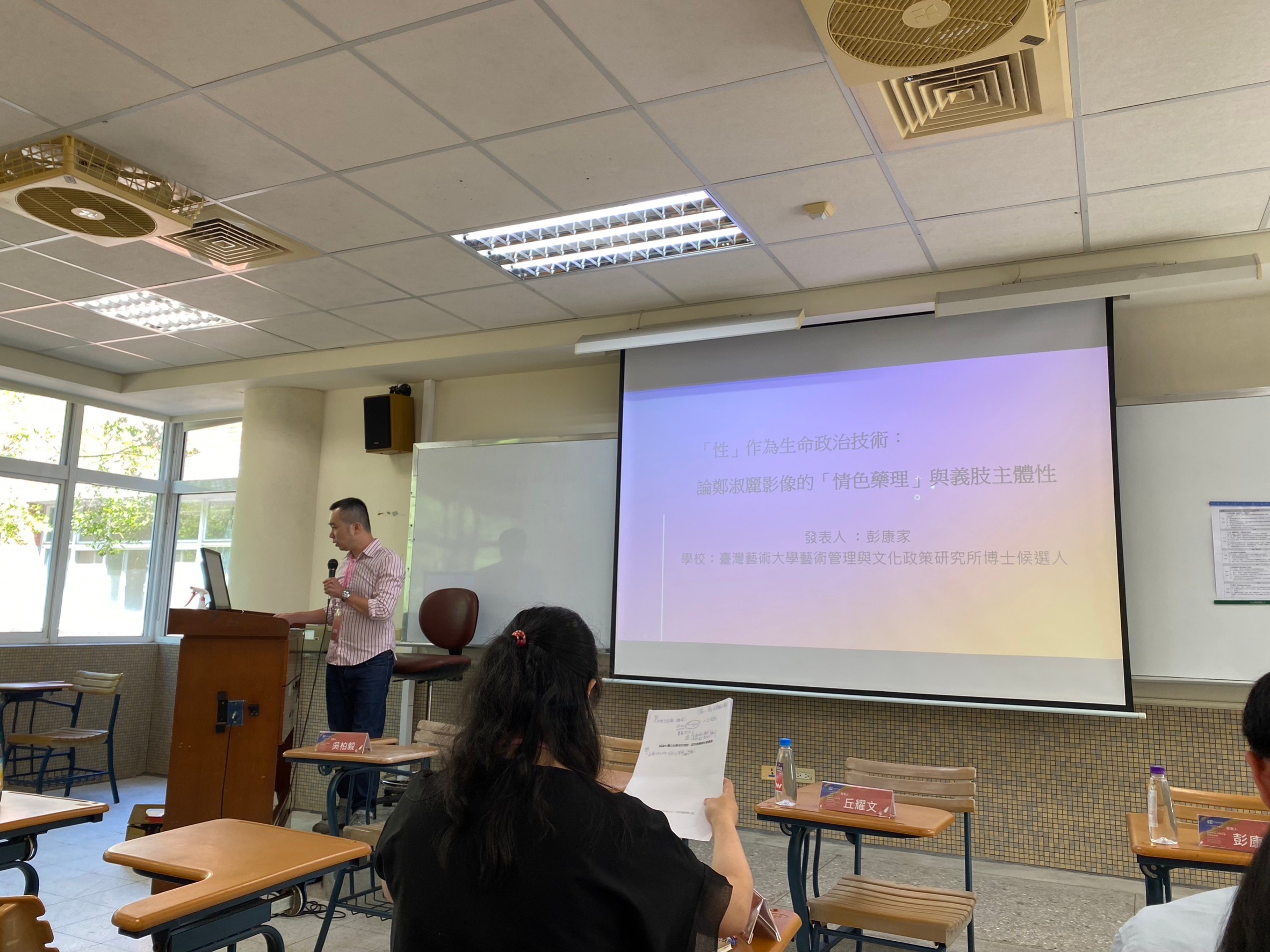策展政治的流變與轉化:從二二八紀念美展到酷兒展演
The becoming and transformation of curatorial politics:From the 2-28 Incident to Queer Performativity
中文摘要
鄭淑麗(1954—)是國際當代影像創作藝術家,遊走於國際間。鄭氏的影像創作《I.K.U.》與《體液Ø》。《I.K.U.》融合科幻、日本文化與情色的故事,《I.K.U.》雖然取材於日本成人色情影片,但創作者藉此批判父權社會、父權文化與情色文化,展現出酷兒的能動性,去挑戰性別既定的想像,以及怎麼看待性別與其想像;本研究聚焦於《體液Ø》作品討論,《體液Ø》大量使用非裔與亞裔,將非白人身體給予物化,其創作灌注了擬像與賽伯格的概念,觀者無法確定其性行為的體液是否為真實或是為虛擬影像,本研究探討鄭淑麗影像中的幻肢⁄假肢的概念,其創作帶有科學史學家唐娜.哈洛威(Donna J. Haraway, 1944-)「賽伯格」政治(Cyborgs)所強調「身體生產的機器」(the apparatus of bodily prodution)的觀點,科技⁄生物學⁄醫學如何介入藝術創作的論述。本研究從學者茱蒂斯・巴特勒(Judith Butler)的操演性(Performativity)概念切入:身份本身是表演性的:一個完全處於與傳統人文主義相悖,結合「賽伯格」(cyborg)的概念探討科技義肢產生性別踰越效果,並產生身體操演之效果。
誠如性別與酷兒理論學者普雷西亞多於《神農毒癮:性,藥物與生命政治》(Testo junkie: Sex, drugs, and biopolitics in the pharmacopornographic era)一書中所說的「情色藥理」(pharmaco-pornographic)資本主義,資本主義如何介入技術政治⁄醫學⁄身體之論述。主要以普雷西亞多「反性慾」(countersexuality)、「反性宣言」(Counter-sexual Manifesto)之論點,質疑自然器官⁄人工塑料、生⁄死之界線,質疑身體健全的二元對立的概念,翻轉受壓迫的邊緣身體、性別、物種與種族的主體性,來看待鄭氏影像創作的後人類展演政治。
本研究並援引義大利與澳洲籍女性主義理論家布達多蒂所說的「跨物種聯盟」(trans-species alliances)或是「橫向組織」(transversal assemblages)之論點,來探討鄭氏影像中所指涉的假肢與人工填充物,進而討論人工科技的身體生產和性的再生產議題與性別、身分認同,以及新的性與情慾政治。
Abstract
Shu Lea Cheang (1954—) is a renowned international contemporary visual artist whose artistic journey transcends geographical boundaries, from New York to Germany, Taiwan to Europe. Over the course of three decades, her artistic endeavors have traversed various forms of visual expression, encompassing documentary filmmaking, experimental cinema, video art, mixed-media installations, performance art, and digital art. In her visual oeuvre, Shu Lea Cheang weaves a rich tapestry of multiculturalism and environmental concerns.
Among her noteworthy creations, "I.K.U." and "Fluid Ø" stand out prominently. "I.K.U." seamlessly amalgamates elements of science fiction, Japanese cultural influences, and elements of erotica within its narrative fabric. Despite drawing inspiration from Japanese adult cinema, the work serves as a potent critique of patriarchy, patriarchal culture, and erotic culture, while concurrently exhibiting the agency of queer identities. It challenges established conceptions of gender and reimagines the ways in which we perceive it. However, this academic inquiry is focused on Shu Lea Cheang 's work titled "Fluid Ø."
"Fluid Ø" extensively employs the bodies of non-caucasian individuals, specifically African and Asian, subjecting them to objectification. This work infuses notions of simulacra and cyborgs, leaving viewers in a state of ambiguity regarding the authenticity of the bodily fluids depicted, blurring the lines between reality and virtual imagery. This research undertaking revolves around exploring the concept of phantom limbs and prostheses within Shu Lea Cheang 's visual repertoire.
Drawing inspiration from the philosopher and queer theory scholar Paul B. Preciado, as expounded in "Testo Junkie: Sex, drugs, and biopolitics in the pharmaco-pornographic era," the concept of "pharmaco-pornographic" capitalism assumes central significance in this scholarly investigation. It delves into how capitalism infiltrates discourses surrounding technology, medicine, and the human body. In doing so, it scrutinizes the concept of prostheses and artificial augmentations alluded to in her work, giving rise to discussions pertaining to the production of synthetic chemicals in the body, the reproduction of sexuality, gender identity, and the emergence of new sexual and erotic politics within contemporary art discourse.
參考文獻
1. 王彥華(譯)(2007)。Mclaren, A.著。二十世紀性史。上海:上海人民出版社。
2. 李如恩(2012)。台灣九○年代酷兒科幻小說中的後人類政治:以洪凌和紀大偉作品為例。國立中興大學台灣文學與跨國文化研究所碩士論文。
3. 宋根成(譯)(2016)。Braidotti, B.著。後人類。鄭州:河南大學出版社。
4. 李寅彰(2020)。當代混媒體藝術的感知間距:以白南準的自然觀及其影響為例。國立臺南藝術大學創作理論研究所博士論文。
5. 李寅彰(2021)。白南準的機器人:混莊媒體與人性化科技的錄像雕塑物,雕塑研究,25:167-214。
6. 周沛郁(譯)(2021)。Sheldrake, M.著。真菌微宇宙:看生態煉金師如何驅動世界推展生命,連結地球萬物,臺北:果力文化。
7. 林建光、李育霖(編)(2013)。賽伯格與後人類。臺中:國立中興大學。
8. 林德祐(譯)(2021)。Milon, A.著。虛擬真實:我們的身體在或不在?。臺北:漫遊者文化。
9. 高千惠(2017)。詮釋之外:藝評社會與近當代前衛藝術運動。臺北:典藏藝術家庭。
10. 張君玫(2020)。人類世中的女性主義:立足點、地方與實踐。中外文學,49(1):13-60。
11. 張君玫(2021)。共生與批判:一個分子女性主義的探討,中外文學。50(3):17-54。
12. 廖育正(2021)。賽伯格莊子:物化主體、技藝與義肢。中外文學,50(1):171-208。
13. 程巍(譯)(2012)。Sontag, S.著。疾病的隱喻。臺北:麥田。
14. 鄭芳婷(2019)。當代愛滋社群政略之悖論:《叛徒馬密可能的回憶錄》之戲劇批判戰術。中外文學,48(3) :133-168。
15. 賴淑芳、李偉柏(譯)(2018)。Hayles, N. K.著。後人類時代:虛擬身體的多重想像和建構。臺北:時報。
16. 謝孟璇(譯)(2018)。Tsing, T. L.著。末日松茸:資本主義廢墟世界中的生活可能。新北市:八旗文化。
17. Braidotti, B.(1994).Nomadic Subjects:Embodiment and Sexual Difference in Contemporary Feminist Theory.New York:Columbia UP.
18. Cvetkovich, A.(2003) . An Archive of Feelings: Trauma, Sexuality, and Lesbian Public Cultures. Durham. NC: Duke UP.
19. Evans, E.(2022).The Body in French Queer Thought from Wittig to Preciado: Queer Permeability, London:Routledge.
20. Gabert-Doyon, J. (2020.03.17). Paranoia and the coronavirus: how Eve Sedgwick's affect theory persists through quarantine and self-isolation. Paranoia and the coronavirus: how Eve Sedgwick's affect theory persist – Verso (versobooks.com), 瀏覽時間:2023/8/6。
21. Haraway, D. J.(2008).When Species Meet, London: University of Minnesota Press.
22. Haraway, D. J.(2016).Staying with the Trouble: Making Kin in the Chthulucene, Durham: Duke University Press.
23. Halberstam, J.(2005). In a queer time and place : transgender bodies, subcultural lives.New York: New York University Press.
24. Sandell, R.(2014). Museums, Moralities and Human Rights, New York: Routledge.
25. Sullivan, N. and Middleton, C.(2020). Queering the Museum, New York: Routledge.
